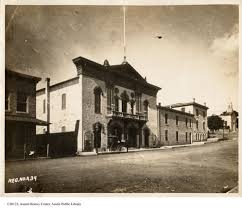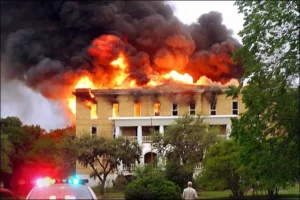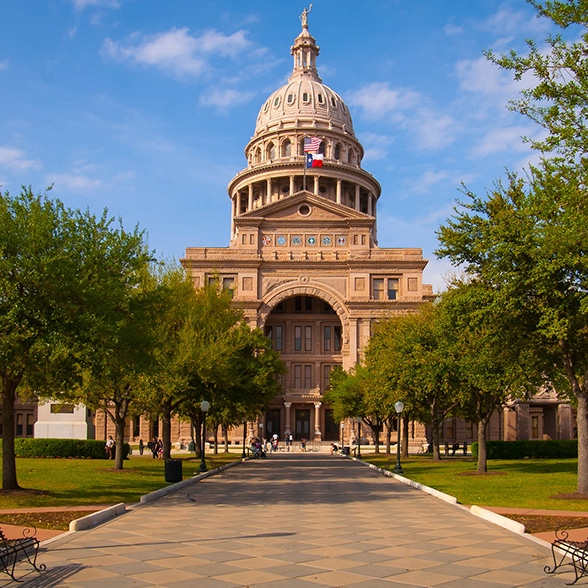The Texas Governor’s Mansion GHOSTS

photo from Texas Escapes
The Texas Governor’s Mansion is the fourth oldest executive residence in the United States and the oldest such structure west of the Mississippi. Built during the years 1854 to 1856, this historic edifice, now a registered National Historic Landmark, has been occupied by every Texas governor since 1856, beginning with the fifth governor, Elisha Pease.
The mansion is one of three impressive and stately Austin residences that were designed and built beginning in the early to mid-1850’s, in the Greek Revival style by prominent architect and master builder Abner Hugh Cook, who had been working as the contractor on woodwork in the Capitol building (Not the one we see today, but the Old Stone Capitol built in 1852-’53). He also built the Sampson Building that we encountered earlier at the corner of 7th & Congress.
The executive residence is made of locally manufactured brick, probably from Cook’s own brick kiln on the banks of Shoal Creek. The pine logs used for the pillars were hauled in from Bastrop where Cook was a part owner of a lumber mill. In June 1856, Governor Pease moved in.
Now, keep in mind that in addition to being President of the Republic of Texas TWICE, Sam Houston was also elected as Governor, but it was during a very contentious time in our nation’s history! During Houston’s term in office, Abraham Lincoln won the presidential election and there was much talk of Texas seceding from the Union along with other states to form the Confederacy. Houston would have none of it. He warned of the dangers of secession and civil war, but his warnings went unheeded.
Refusing to take the oath of loyalty to the newly established Confederate States of America, Houston was removed from office and replaced by the lieutenant governor. Houston left the Governor’s mansion disillusioned and, let’s face it, feeling betrayed by the state he loved and defended in blood and battle for so long. He died in Huntsville in 1863.
It is said that Sam Houston’s ghost haunts the Governor’s Mansion, more specifically the bedroom which he occupied while in residence as governor and for which he bought the mahogany four-poster bed with which it is furnished. His portrait still hangs behind the bed.
It was not long after his death that visitors to the mansion began to report catching glimpses of the old hero whose image would vanish when spoken to. Some say that Houston has returned to the mansion because his spirit is haunted by thoughts of the tragic historical circumstances which led to his early departure from his lofty position. There are reports of heavy boot steps pacing, pacing back and forth in that bedroom throughout the night – like the night before he wrote his letter resigning from office.
In the mid-1980’s the wife and the daughter of Governor Mark White encountered Houston’s presence. Elizabeth White, the governor’s daughter, stated that something about the bedroom across the hall from that of her parents frightened her and so she avoided it. The bedroom in question, of course, was Houston’s. First Lady Linda White, also had an experience that has been attributed to Houston’s restless spirit. Awake later than others in the home, she turned off a light in the Houston bedroom which had been left on over his portrait. The First Lady made several attempts to keep the light off, but a few minutes after turning it off the light would turn back on.

The best known ghost story of the Governor’s Mansion concerns a suicide in 1865. The governor of Texas was Pendleton Murrah. After months of one dismal war report after another, Murrah decided to use the remaining money in the Texas treasury in a positive way: by throwing a big party. (Invitation only. No riff raff.)
One of the guests at the party was a young man fresh out of officers’ school, looking very dashing in his Confederate uniform with hat, boots, saber and pistol. Another guest was a young lady he spotted across the ballroom. He was immediately smitten, and despite learning that the young woman was the niece of the governor and his own distant cousin, he worked up his courage to ask for her hand in marriage. (After all, he was going off to war, he had to act fast!)
The young lady not only spurned him, she laughed in his face at which point the young man went up to the northwest corner of the mansion and shot himself in the head. Well, even back then, that will end a barbecue pretty quickly. The tragedy is that even if the young man had brushed off this young lady’s refusal, when he went off to war the next day, he probably would have been met by a platoon coming from the other direction to tell them that the war was over, and there was no need to ride any further.
Perhaps he did learn of that once he got to the other side, because anguished wails and moans could be heard in the bedroom and that servants thus refused to enter the room to clean it. The room was often found to be ice-cold, and due to a mysterious banging noise no one could ever sleep therein so the next governor, Union-appointed Andrew J. Hamilton, had the room sealed. Yet the cold breaths, rattling, moaning, and turning of doorknobs continued such that housekeeping staff dreaded this portion of the house, avoiding it whenever possible. The situation remained so until well into the twentieth century when the room was unsealed. The sounds even then were said to still be heard, especially on Sundays, the day on which he ended his life. We have it on good authority that the sounds can still be heard to this very day. When one of our tour guides John Maverick asked Governor Anne Richards about that section of the mention, she leaned in close and responded, “Oh, honey, that room is just freaky!!”
Even Governor Murrah is said to still be hanging around. When it became certain that Union troops would occupy Texas, Murrah escaped – by climbing out a back window of the mansion…oh, and without telling his wife. He joined other Confederate leaders on the run in Mexico where he died of tuberculosis later that summer.
It is rumored that the ghost of Governor Murrah haunts the mansion and that the apparition has been seen both inside and outside the mansion.
Also rumored is that the ghost of a woman is among the spirits of the mansion, the specter of an unmarried maid who was dismissed from employment when her pregnancy became apparent. She waits outside the house, as if in hopes of being invited back.
Another ghost is that of a black soldier in a Union uniform who was stabbed to death by less tolerant Union soldiers guarding the mansion.
Having undergone several renovations over the years, such as during the Governor William P. Clements administration and the Governor George Bush administration, the historic edifice had again been closed several months while undergoing a $10 million refurbishing when in the early morning of June 8, 2008, it was extensively damaged by fire, the result of arson. Fortunately, countless valuables including Houston’s four-poster bed, Stephen F. Austin’s writing desk, and numerous other valuable pieces of art and antique furniture had been removed and were in storage at the time of the fire. Security cameras caught images of an intruder before the setting of the blaze, but it is not clear if the arsonist acted alone. No one was hurt in the fire.
A common theme in ghost stories is that spirits become agitated during remodeling or restoration of buildings. The question was, had the tragic fire driven them away?
While Austin Ghost Tour Guide Monica was employed by the State Preservation Board, she was being trained to give tours at the mansion just prior to its reopening. She covertly asked DPS officers on duty, “So after all the renovations, are the ghosts still around?” Without hesitation, the biggest guy in uniform responded, “Oh, HELL yes!”
That seems to have answered that!
If you care to see the INSIDE of the mansion, you have to arrange that a few days in advance so that you undergo a background check. And as you can see, security at the gate is a little tighter nowadays. Invitation only. No riff raff.

ANOTHER VERSION OF THE TEXAS GOVENOR’S MANSION GHOST
Governor Bush was bold enough to bring up the delicate subject of the paranormal about one month ago when he had a run-in with the spectral that has been seen on the second floor of the mansion since 1864. The Bush family private residence is on the 2nd floor. On the evening of June 26th the Bush’s were hosting a dinner to honor Texas artist. As Gov. Bush entered the upstairs hallway he saw a young man dressed in a full military uniform walk through the closed door opposite from where he was standing. Shaken, he requested that the 2nd floor be searched. No one was found.
The mansion does have a sad story attached to its ghost. In 1864 Gov. Pendleton Murrah and his wife were hosting a dinner party. In addition to his peers the Gov. invited some enlisted men close in age to his daughter and her friends. The evening was progressing along nicely; everyone seemed in good a disposition including his 16 year-old daughter. What this young man was thinking we
can only guess; perhaps his passion was due to the anxiety created when a country is at war, or perhaps his hopelessness came from the realization of death every soldier must consider when faced with battle. Whatever the reason, this young man felt such strong emotions towards the Governor’s daughter that he asked her to marry him on this, the night that they met. He would be in Austin a few more weeks before his company planned to head back to Georgia. There was time, but she declined the offer. Not long after the rejection he went up the stairs to one of the small back rooms on the 2nd floor and shot himself.
Following this tragedy the room was closed off. The wall remained stained with his blood until 1870 when Gov. Andrew Hamilton took office.
The most depressed time in the Governor’s Mansion’s history were the years during the Civil War. Few formal social events took place. Most luxuries were unavailable, and many items heretofore taken for granted were scarce. To make matters worse, Governor Pendleton Murrah was nursing an advanced case of consumption (tuberculosis).
The ghost at the mansion began appearing following the tragedy that took place during Murrah’s 16-month tenure as governor. The incident took place, ironically, after one of the few festive parties the Murrahs’ endeavored to host. At the dance, many officers and ladies were able to relax and, if only briefly, forget about the war. A niece and nephew (not brother and sister) of Murrah spent much of the evening together. She was enjoying his company, and he was falling in love. At the end of the evening, he professed his love for her and proposed marriage. She in turn laughed and rejected his offer. Devastated, he went into the back north room and shot himself.







